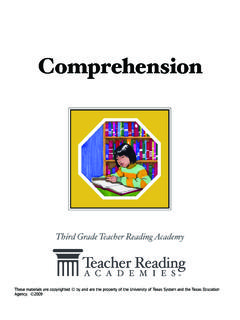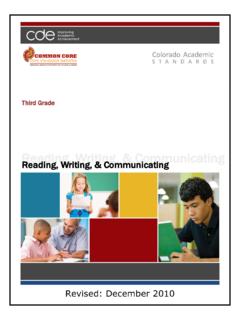Transcription of Library Media rd3 Grade Quarter 1 Concepts: Skills ...
1 Library Media 3rd Grade Quarter 1 Concepts: Skills : Concepts of Print Parts of a Book, Author and Illustrators, genre studies understanding , applying Standards: Strand 2: Students develop an awareness of and interaction with literature in a variety of formats for the purpose of personal enrichment and information. Standard 7: Students explore print material to learn how physical features of books and other resources contribute to meaning. Objective 2: Demonstrate an understanding of the physical features of books and other Library resources.
2 Standard 8: Students explore various aspects of literature in books and other formats. Objective 1: Identify the contribution of authors and illustrators in the creation of literature. Objective 3: Explore and compare different types of literature to enrich and expand the reading experience. Standard 9: Students value the contribution of reading to becoming self-directed, lifelong learners. Objective 1: Listen to and Read a variety of literature to enhance selection. Library Content Objectives Vocabulary students should use Lessons I can locate and define the parts of a book.
3 I can identify and use features of electronic resources. I can identify different locations in a Library . I can identify the author and/or illustrator of a book. I can use my Library OPAC (Destiny) to locate resources within my school Library and the public Library . Cover Title Bibliography Appendix Preface Table of Content Title Page Index Glossary Author illustrator Publisher Fiction Non-Fiction Electronic resources Scroll Hot links Menu Parts of a Book Authors and Illustrators Genre studies (fantasy, realistic fiction, ect.)
4 Guess the Genre Alphabetized for a Reason The Way a Library works Using your Library OPAC Information Literacy Language Objectives Additional Resources Utilize the parts of a book to locate information needed. Pursue literature and print materials related to literacy genres. Recognize and appreciate artistic components of works. Locate and use items in a Library Parts of a Book Multiple Powerpoints Parts of a Book Hangman Parts of a Book matching game Thinkquest Parts of a Book Genres of Literature games reading Genres Posters How Libraries work Genre Quizlet TeacherVision- Library Resources UEN Shelving and Finding Books Media Center Lessons 3-5 Genre studies Media Center Lessons Author and Illust.
5 studies Assessment Options: Quizzes, Discussion, Procedure quiz, Library notebook, demonstration, reading Log 12/16/13 Library Media 3rd Grade Quarter 2 Concepts: Skills : Concepts of Print (cont). Fiction vs. Non-Fiction, Dewey Decimal Systems, Reference understanding , applying Standards: Strand 2: Students develop an awareness of and interaction with literature in a variety of formats for the purpose of personal enrichment and information. Standard 7: Students explore print material to learn how physical features of books and other resources contribute to meaning.
6 Objective 2: Demonstrate an understanding of the physical features of books and other Library resources. Standard 8: Students explore various aspects of literature in books and other formats. Objective 1: Identify the contribution of authors and illustrators in the creation of literature. Objective 3: Explore and compare different types of literature to enrich and expand the reading experience. Standard 9: Students value the contribution of reading to becoming self-directed, lifelong learners. Objective 1: Listen to and Read a variety of literature to enhance selection.
7 Library Content Objectives Vocabulary students should use Lessons I can locate and read informational works. I can demonstrate that I understand the difference between fiction and non-fiction. I can locate materials in the Library based on call numbers. I can identify the types of books and materials that I enjoy reading . Fiction Non-Fiction Dewey Decimal Call Number Biography Easy Books Chapter Books Graphic Novel Reference World Book Pioneer Library Dictionary Thesaurus Encyclopedia What is Fiction & Non-Fiction understanding The Dewey Decimal System Looking at the Dewey 100 s and 10 s How Does Dewey Help Me The Reference Section of my Library Dictionaries and Encyclopedias Information Literacy Language Objectives Additional Resources Describe the relationship between fiction and non-fiction text.
8 Use information gained from illustrations and words to demonstrate understanding . Locate and read informational text and resources. Engage in collaborative discussions Quizlet Fiction, Non-fiction & Dewey Flashcards Dewey Decimal PowerPoints Enchanted Learning The Library Teacher Vision Dewey Links Lesson Planet Dewey Lessons Review on Fiction vs. Non. Dewey and the Alien story UEN Dewey Decimal Dewey Decimal Game Pioneer Library - Worldbook Assessment Options: Quizzes, Discussion, Procedure quiz, Library notebook, demonstration, reading Log 12/16/13 Library Media 3rd Grade Quarter 3 Concepts: Skills : Information Literacy Research Skills Apply, Analyze, Evaluate, Create Standards: Strand 1- Information Literacy Standard 1: Students define an information problem and identify information needed to solve the problem.
9 Standard 2: Students identify, evaluate, and select potential information resources available in or through the school Library Media center. Standard 3: Students locate resources and access information within resources. Standard 4: Students engage and extract Information. Standard 5: Students, organize, synthesize and present information. Standard 6: Students evaluate the product and the process. Library Media Content Objectives Vocabulary students should use Lessons I can identify a topic with a teachers help. I can create a plan for finding the information that I need.
10 I can use the information to create something that I can share with others. I can evaluate to see if I am done with my project and have done everything I was suppose to do. research information topic task sources resources product print materials Electronic Resources Information Literacy (Research Skills ) o Plan (Make a research plan) o Do ( Locate Resources, Use information and Share your Research) o Review (Reflect on the Process) Research topic should be selected from a content area such as Science, Social studies Information Literacy Language Content Additional Resources Determine the main idea of a text, recount the key details and explain how they support the main idea.











